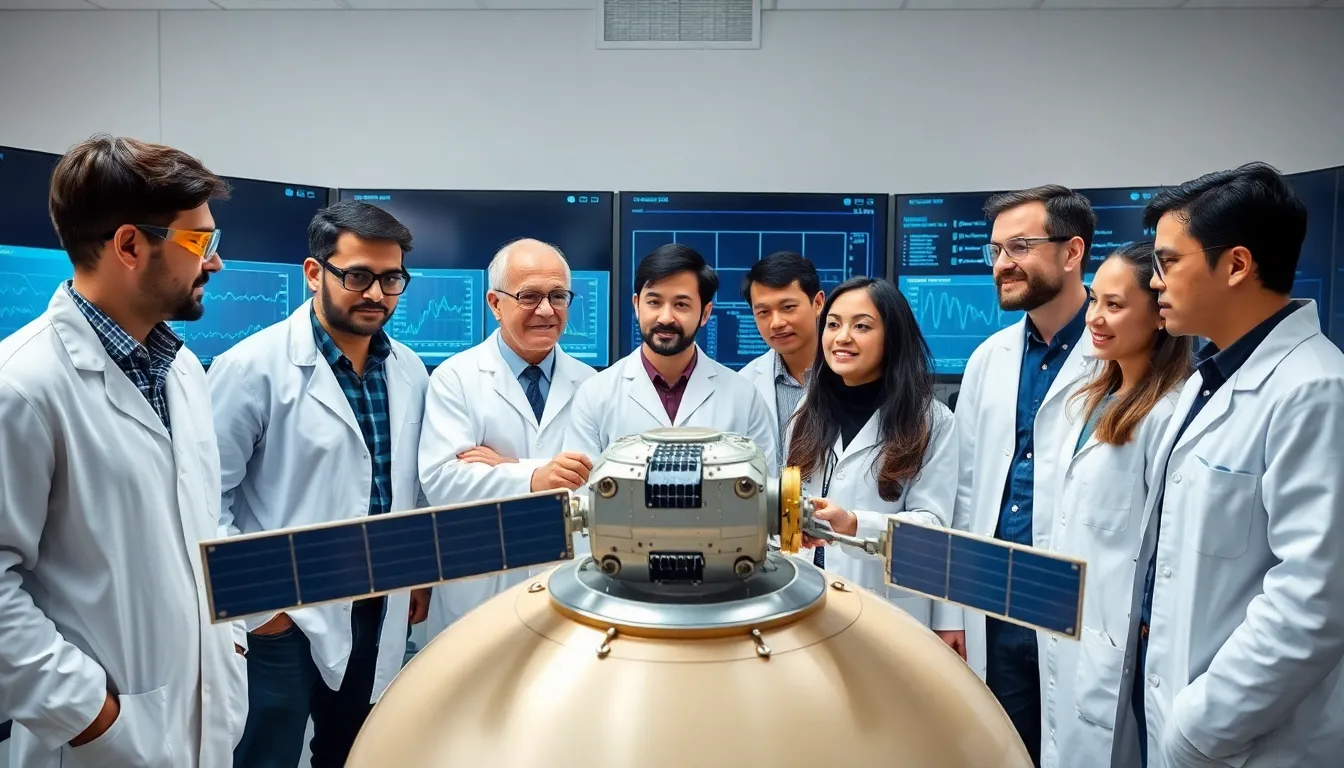Space technology isn’t just for astronauts and sci-fi enthusiasts; it’s the secret sauce behind everything from GPS navigation to weather forecasting. Imagine a world where your favorite pizza delivery can’t find you because satellites are on strike. That’s the reality without space tech, and it’s more crucial than ever in our daily lives.
Table of Contents
ToggleWhat Is Space Technology?
Space technology encompasses the tools, systems, and techniques used to explore and utilize outer space. It includes a variety of disciplines such as aerospace engineering, telecommunications, and materials science. Many components of space technology enable advancements in satellite design, propulsion systems, and remote sensing.
Satellites exemplify a crucial aspect of space technology. They provide vital services, including communication, weather monitoring, and Earth observation. These satellites support navigation systems like GPS and facilitate global telecommunications. This broad range of applications illustrates the interconnectedness between space technology and everyday life.
Launch vehicles represent another essential element in the field. They transport satellites and other payloads into orbit. Various types of launch vehicles, including expendable and reusable rockets, enhance access to space. By making launches more cost-effective and efficient, they expand opportunities for scientific research and commercial ventures.
Robotic spacecraft play a significant role in space exploration. These unmanned vehicles conduct missions beyond Earth’s atmosphere, collecting data from planets, moons, and asteroids. Missions like Mars rovers and deep-space probes showcase the capabilities of robotic technology. Each successful mission adds valuable knowledge about the solar system and beyond.
Ground stations support the operation of satellites and spacecraft. These facilities track, analyze, and communicate with space assets. Ground stations ensure that data is transmitted back to Earth, allowing real-time operations and support for missions.
Overall, space technology drives innovations that extend to various sectors. From improving telecommunications to enhancing scientific understanding, its influence is profound. As advancements continue to emerge, the potential for future developments expands significantly.
The History of Space Technology

Space technology has evolved significantly, rooted in early science and engineering initiatives. Historical context showcases progression in understanding outer space.
Early Developments
Early developments in space technology trace back to the mid-20th century. The launch of Sputnik 1 by the Soviet Union in 1957 marked the first artificial satellite in orbit. This achievement sparked global interest in space exploration. The United States launched Explorer 1 in 1958, contributing to scientific research with discoveries like the Van Allen radiation belts. Groundbreaking work on rockets by pioneers such as Robert Goddard and Wernher von Braun laid essential foundations. These early efforts set the stage for advancements in satellite technology and human spaceflight.
Key Milestones
Key milestones in space technology showcase remarkable progress and achievements. The Apollo 11 mission in 1969 resulted in humanity’s first moon landing, showcasing capabilities in crewed space travel. In 1971, the Soviet Union launched the first space station, Salyut 1, pioneering long-term human presence in orbit. The deployment of the Space Shuttle program in 1981 enabled reusable spacecraft, shifting mission dynamics. More recently, advances in satellite technology, such as GPS and communication satellites, revolutionized everyday life. The Mars rovers, including Curiosity and Perseverance, exemplify ongoing exploration beyond Earth. Each milestone reflects collaborative efforts and significant scientific advancements.
Types of Space Technology
Space technology encompasses various categories that enable and enhance our exploration and utilization of outer space.
Satellite Technology
Satellites play a pivotal role in modern communication and Earth observation. They facilitate GPS navigation, weather forecasting, and global telecommunications. These orbiting assets collect data that supports climate research, disaster monitoring, and environmental tracking. Different types exist, including communication, remote sensing, and scientific satellites. Communication satellites relay television signals and internet data, while remote sensing satellites gather vital imagery for agriculture and urban planning. Scientific satellites explore cosmic phenomena, contributing to our understanding of the universe.
Propulsion Systems
Propulsion systems are essential for launching spacecraft and maneuvering them in space. These systems include chemical rockets, ion thrusters, and nuclear thermal engines. Chemical rockets use combustion to produce thrust, allowing them to lift payloads into orbit. Ion thrusters offer efficient propulsion for deep space missions by expelling ions at high speed. Nuclear thermal engines, still under development, promise to provide higher efficiency for future crewed missions to distant planets. Each system enables different mission profiles, ensuring that spacecraft can reach and explore various destinations effectively.
Space Exploration Vehicles
Space exploration vehicles encompass crewed and uncrewed spacecraft designed for missions beyond Earth’s atmosphere. Crewed vehicles, like the Space Shuttle and Crew Dragon, transport astronauts to the International Space Station and facilitate deep space travel. Uncrewed spacecraft include robotic rovers and landers that conduct scientific research on other celestial bodies. Rovers such as Mars Curiosity and Perseverance analyze soil and atmosphere, seeking signs of life and understanding planetary geology. Each vehicle design focuses on the mission’s specific objectives, significantly enhancing our knowledge of the solar system.
Applications of Space Technology
Space technology finds numerous applications that impact daily life and advance scientific understanding.
Communication
Satellites serve as the backbone of global communication systems. They facilitate telecommunication by providing critical infrastructure for voice, data, and video transmission. Companies rely on satellites for broadcasting television and delivering internet services to remote areas without ground-based infrastructure. Many businesses, including those in telecommunications and finance, utilize satellite technology for real-time communication and data transfer. Mobile devices often leverage satellite signals to ensure reliable connectivity in various locations. In addition, emergency response teams use satellite communications during natural disasters to maintain contact and coordinate rescue efforts.
Weather Forecasting
Weather satellites play a crucial role in meteorology by providing essential data for weather prediction. They gather information on atmospheric conditions, cloud cover, and storm patterns. Meteorologists analyze this data to create accurate forecasts, helping communities prepare for severe weather events. Such systems monitor climate change by tracking long-term variations in temperature and precipitation. Early warning systems, based on satellite data, enable timely alerts for hurricanes, tornadoes, and flooding. Governments and agencies use this information to implement safety measures, minimizing damage and protecting lives.
Scientific Research
Space technology supports extensive scientific research across multiple disciplines. It enables the exploration of other celestial bodies through robotic spacecraft and rovers. Mars missions, such as Curiosity and Perseverance, analyze soil and atmosphere, offering insights into potential life beyond Earth. Telescopes in orbit provide astronomers with clear, unobstructed views of distant stars and galaxies. Furthermore, experiments conducted in microgravity aboard the International Space Station contribute to advancements in medicine and materials science. This ongoing research enhances human knowledge and fosters innovation across scientific fields.
Future Trends in Space Technology
Future developments in space technology emphasize innovation, commercialization, and improved propulsion systems.
Commercial Space Exploration
Interest in commercial space exploration has surged, with private companies leading groundbreaking initiatives. SpaceX, Blue Origin, and Virgin Galactic are examples of enterprises advancing space tourism and satellite deployment. These companies aim to reduce launch costs while increasing access to space for research and tourism. Partnerships with government agencies like NASA enhance capabilities, enabling shared missions for lunar bases and Mars habitation. This trend in privatization encourages investment in space infrastructure, creating a competitive environment that fosters technological advancements.
Advancements in Propulsion
Innovations in propulsion systems transform space travel efficiency. Electric propulsion, such as ion thrusters, offers significant fuel savings while providing continuous thrust over long durations. Research into nuclear thermal propulsion aims to shorten travel times to Mars and beyond, making deep space missions feasible. Companies and agencies explore hybrid engines that combine chemical and electric systems to balance power and efficiency. These advancements not only lower mission costs but also expand the range of potential exploratory missions within our solar system.
Space technology shapes the modern world in profound ways. Its influence extends beyond exploration and research, directly impacting daily life through services like GPS and weather forecasting. As advancements continue to emerge, the potential for innovation grows, paving the way for new applications and discoveries.
The evolution of space technology reflects humanity’s relentless pursuit of knowledge. From historic milestones to cutting-edge developments, each step forward enhances understanding of the universe. As commercial ventures expand and new propulsion methods are explored, the future of space technology promises to be even more exciting. The journey into the cosmos is just beginning, and its implications will resonate for generations to come.




